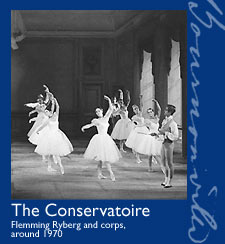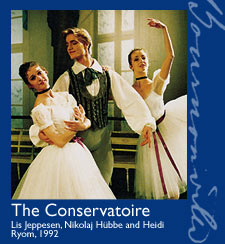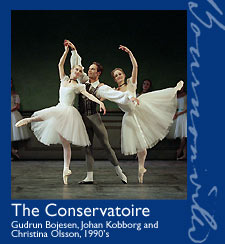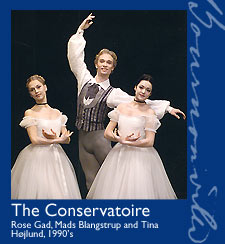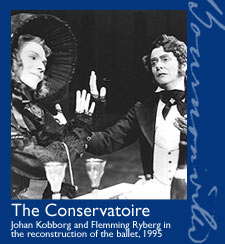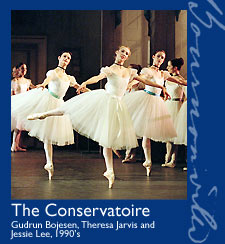|
|
|||||
|
Performances by
|
|||||

|
|
Historical Background More Than Just a Dancing School The purest ballet scene in all of Bournonville’s works, that is how one could describe the divertissement The Dancing School of the ballet Le Conservatoire. Here, it is the dance itself that is the point of the story. By creating a plot that sets off in a dance studio, Bournonville has made it possible to show off his delicate and very demanding exercises in their most purified form on stage. It is not just any dance studio but a dance studio at the Conservatoire in Paris. Bournonville knew these ballet classes from his own youth in the 1820es where he studied at the Conservatoire with the renowned Auguste Vestris as one of his teachers. Creating the ballet of Le Conservatoire - or a Marriage by Advertisement (Konservatoriet eller Et Avisfrieri) for the Royal Danish Ballet in 1849, Bournonville assembled his youth memories in a cheerful and harmless vaudeville ballet. Charming excuses for dancing As always in Bournonville’s ballets, the plot involves plenty of charming excuses for introducing different dance divertissements throughout the ballet. Not the least in the second act where the pupils of the Conservatoire make a fool of Monsieur Dufours by dressing up as attractive women - in disguise, of course. From two acts to one - and back again However, in 1995 the Royal Danish Ballet again chose to bring the complete two-act version back into the repertoire. Such a deed was only possible due to a very experienced trio of Bournonville experts: The Bournonville teacher Kirsten Ralov (1922-99) who was former Assistant Director and principal of the company and who originally danced the little, talented girl Fanny in the 1933-staging. The principal Niels Bjørn Larsen (born 1913) who became one of the greatest mimes of the century and who danced one of the young dancers in The Dancing School in 1933. And finally, the Bournonville teacher Dinna Bjørn (born 1947 and daughter of Larsen), who has been teaching Bournonville’s special style throughout the world since the 1970s. This restaging itself became a proof of Bournonville’s strong heritage. By combining personal memories with the old notations by Bournonville - and with writings by Valborg Borchsenius from Harald Lander’s staging in the 1930s - the three directors made it possible to stage the old ballet. And thanks to the dancers and their ability of creating Bournonville’s Golden Age figures - a special style of mime, not the least - the ballet actually managed to come alive on stage again. A basic grand plié The Dancing School is simply one of the finest examples of Bournonville’s ability of creating interesting choreography out of very simple steps. Just take a look at the very first movement of the Dancing Class. That is something as plain as a grand plié - a deep bending of the knees with the feet together, heel by heel in the so-called first position. Such a grand plié is the basic exercise above all in classical ballet: it warms, stretches, makes supple and strengthens, and as such it is done as the beginning exercise in the daily training and warm-up by every single ballet dancer in the world, first at the barre and later out on the floor. Yet, it is obviously extremely difficult to perform on stage without the slightest trembling. In his choreography, Bournonville turns this basic knee bending into art. And this is really the key to the ballet The Conservatoire, the respect for the essential movements of the classical ballet - combined with the musical ease and the inherent grace. The respect, that lifts Bournonville’s choreography up from the gymnastics into the sphere of the arts. Anne Middelboe Christensen (born 1964), M.A. Assistant professor of dance history at University of Copenhagen and dance critic at the Danish daily Information and dance correspondent for international magazines such as Dance Magazine and Tanz International. She gladly receives your comments at anne_middelboe_christensen@information.dk |






